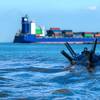NRC Contractors, Adam Wilkison, Collin Potts and Ron Broadway, put up a barrier of think plastic to prevent fuel from escaping the containment area around a damaged tank at the BP Harbor Island Seattle Terminal Dec. 6. The Coast Guard, Washington Department of Ecology and BP worked with NRC contractors to keep any of the fuel from entering Puget Sound. (Official Coast Guard photo by Petty Officer Shawn Eggert)
NRC contractors meet to discuss their plans to keep diesel fuel from escaping a damaged tank and entering into Puget Sound at the BP Harbor Island Seattle Terminal Dec. 6. The container leaked one gallon of fuel into a containment area after damage to its roof was found Dec. 5. (Official Coast Guard photo by Petty Officer Shawn Eggert)
An oil storage tank containing 4354 barrels (approximately 182,000 gallons) of diesel fuel leaked approximately one gallon of diesel into the tank's secondary containment Wednesday.
The report originally estimated 4500 barrels, but was revised down upon completion of the transfer. The container reportedly leaked the fuel after damage to its floating roof caused an access ladder to become twisted and partially pulled into the tank. The British Petroleum (BP) facility is located on Harbor Island. The Coast Guard and Department of Ecology responded immediately to ensure that appropriate mitigation and response measures were taken to minimize the threat of environmental damage.
BP hired contractors to pump all of the fuel from the faulty tank. The 4354 barrels of fuel were completely removed from the tank.
The tank is surrounded by a secondary containment wall, which is designed to contain the oil should it be released from the tank. The containment wall is located on the facility approximately 200 yards from the edge of the Duwamish River. In addition, protective plastic sheeting was placed around the containment area to prevent the fuel from leaking through the facility pier and into the water.
While the chances of oil reaching the waterway were unlikely, BP Arco employed three oil spill response organizations to blank off storm drains, pre-position oil booms and other equipment on the water for contingency response.
Sponsored Content
Chris-Marine’s solutions help to prolong engine lifetime

Subscribe for
Maritime Reporter E-News
Maritime Reporter E-News is the maritime industry's largest circulation and most authoritative ENews Service, delivered to your Email five times per week










